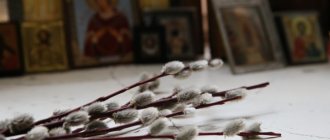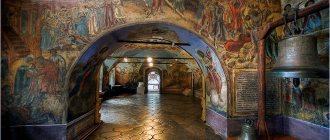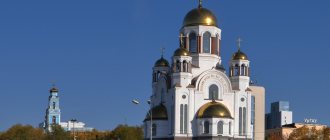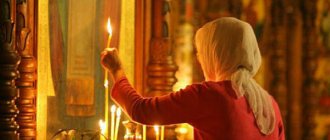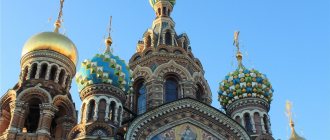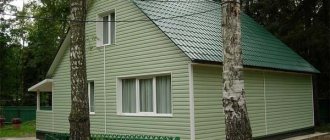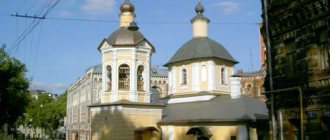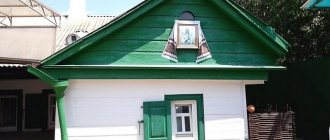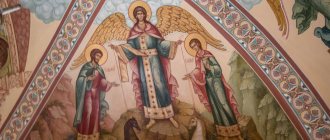Since ancient times, in Russia there has been a tradition of erecting temple-monuments, which were dedicated to both heroic and tragic dates.
When we went to St. Petersburg , we were struck by the Church of the Savior on Spilled Blood, standing on the Griboyedov Canal. Inside the church, a small section of the pavement is preserved, where Tsar Alexander II fell, mortally wounded by a bomb from the Narodnaya Volya member Grinevitsky.
In Uglich , where Tsarevich Dmitry was killed, there is a similar temple.
But the third Church on the Blood was built in Yekaterinburg . To be precise, its full name is: Church on the Blood in the name of All Saints who shone in the Russian land.
Temple - symbol
The temple is located on Voznesenskaya Hill, and it seems to rise above the usual urban development, involuntarily attracting attention to itself. Coordinates : 56.84438, 60.60887.
Yekaterinburg took a long time to build the Church of the Savior on Spilled Blood, and this is no coincidence. Its construction is a people's initiative.
Since, by order of the then owner of the Sverdlovsk region, Boris Yeltsin, the Ipatiev house was demolished at the end of the Soviet era, the vacant lot that arose in its place turned into a place of worship. Ordinary people brought fresh flowers here and left lit candles.
And at the end of the 80s, a memorial cross, first wooden, then metal, appeared on the vacant lot. Then it was complemented by a small chapel and a temple stone. The construction of these memorial structures was not met with unanimous approval by the city residents. The cross and chapel were repeatedly destroyed and set on fire by vandals.
In the 1990s, there were many contenders for this iconic place. What were they planning to build here! A house of worship that unites all religions, a bank, a shopping center and a hotel. But still, at the beginning of this millennium, a decision was made to build a memorial temple on the blood.
After all, this place is the most important part of our country’s past. Once upon a time, on the site where the cathedral now stands, there was a brick mansion, which would never have made it into Russian history if not for the tragic events associated with it. This is Ipatiev's house, which was a typical civil building for its time.
How to get there
The church ensemble is located in the very center of the city. There are several stops around the temple, the closest to it is “Youth Theater”. Therefore, it is more convenient to get to it by ground transport. This:
- buses No. 1, 13, 13a, 15, 018, 21, 23, 48, 53, 57 and 57a;
- trolleybuses No. 1, 3, 5, 9, 11, 15, 17, 18;
- minibuses No. 021, 052 and 056.
If you decide to get to the cathedral by metro, then you need to get to the Dynamo station and walk 750 meters along the square. Here you can see several city attractions: the Cosmos concert hall, the Literary Quarter and the City Pond.
Ipatiev House
The house was built in 1880, and in 1908, former military man and travel engineer N.N. Ipatiev bought it for himself. He was a worthy man who earned his living by his own labor, was passionate about the history of his region and willingly helped the poor. Ipatiev expected to spend a quiet old age in the new house, since at the time of the purchase he was already an elderly, retired staff captain.
But as often happens, private life was broken by turbulent social events. In October 1917, the Bolsheviks came to power in Petrograd, and at the end of the same year, Ipatiev was forcibly evicted from the house he owned, and he received the keys back on July 17, 1918. But he did not want to return here and soon went into exile.
During the Soviet years, the Ural Museum of the Revolution was located here, then the anti-religious museum and various other Soviet offices. In September 1977, by order of the then authorities, the Ipatiev house was demolished.
But it turned out that the memory cannot be destroyed. And so the life of the inconspicuous engineer Ipatiev became intertwined with the fate of the royal family.
Last royal days
At the beginning of March 1917, at the Dno station on the way from the front to Petrograd, Tsar Nicholas II signed his abdication of the throne. The country began to experience chaos in the struggle for power, street protests and rallies, and military defeats, which ended with the establishment of Soviet power.
During this period, the imperial family was first under arrest in the Alexander Palace, and at the end of the summer of 1917 they were taken to Tyumen. In April of the following year, the All-Russian Central Executive Committee decided to return the former tsar and his family to Petrograd for a public trial. However, during the outbreak of the civil war, the prisoners were only able to be transported to Yekaterinburg, where a house was expropriated for them. This was the house of engineer Ipatiev, who was simply put out into the street from the premises that belonged to him.
The royal family was housed in several rooms on the second floor. The house was surrounded by a solid fence. They established a prison regime with rare walks and constant searches.
Despite the fact that a regime of increased secrecy was maintained in relation to the prisoners, and the Ipatiev House received a new official name as the House of Special Purpose, the residents of Yekaterinburg knew well who was being held there and, most likely, guessed what awaited them.
The prisoners themselves understood this. However, they thought that there should be a trial of the emperor and possibly his wife. But few could have imagined that all family members, including children, as well as people from the immediate environment, would be eliminated.
However, the White offensive made its own adjustments to the plans of the Bolshevik leadership. It decided that it was politically dangerous to leave anyone from the imperial family alive. There was no time left to prepare an open trial of the king, and as a result, a decision was made to shoot all the prisoners of the special house.
This event in Russian history is surrounded by secrets and riddles. It is not very clear who gave the order to execute not only the former tsar, but his wife, children and people, how this action took place, and how the subsequent burial was carried out. Many legends and periodically emerging impostors are a consequence of that secret state crime.
A symbolic historical fact: this Romanov dynasty began its royal journey in the Kostroma Ipatiev Monastery, and the basement of the Ipatiev House in Yekaterinburg became the place where not only its reign, but also its physical existence ended on the night of July 17, 1918.
Architectural solution
When you climb the steps of the long temple staircase, you are overcome by some unusually solemn feeling. The bulk of the cathedral, built in the Byzantine style, looms before your eyes. It seemed to us that this was not done by chance. This emphasizes the connection with the homeland of Orthodoxy and one of the greatest empires of antiquity - the Eastern Roman Empire, to which Russia has always considered itself the successor.
The lower part of the walls of the cathedral is decorated with reddish granite and marble, symbolizing the blood shed here.
The temple is five-domed, golden-domed, snow-white, vertically directed upward and as if floating against the blue sky. This effect of weightlessness of such a monumental colossus, as it seemed to us, is created due to the fact that it stands on a hill and, despite all its power, leaves the impression of lightness. We decided it was symbolic.
The main dome looks like a burning funeral candle, and the very harmonious simplicity of the majestic cathedral, its elevation above the usual urban development, seem to speak of the merging of the soul with the sky, the ease of transition into another existence.
Lower and upper temple
The first thing we saw when approaching the temple was a sculpture depicting people walking towards their death.
In front of the temple there is a monument to the royal family. This is a symbolic cross and a spiral staircase descending from it, on the steps of which 11 people have already stepped: Tsar Nikolai Alexandrovich, Tsarina Alexandra Feodorovna, their five children, doctor E. Botkin, maid A. Demidova, valet A. Trupp and cook I. Kharitonov . The Church on the Blood is divided into two tiers: upper and lower, each of which has its own symbolism.
The lower temple is the basement where the murder took place. This is where we started our inspection. Its consecration took place on April 18, 2010.
What surprised us? Low arches, twilight and a general atmosphere of tragedy. This is understandable. The plan of the Church on the Blood repeats the plan of the Ipatiev house and its basement, where the murder of the royal family took place almost a century ago.
In this part of the cathedral there is a calm and strict atmosphere, everyone speaks in a half-whisper, although we did not see any official warnings about this.
On the right are memorial plaques with the names of all members of the royal family. And the main shrine is the altar, erected at the site of the death of the royal family.
On the left is a memorial cross and plaques with the names of the assistants of the royal family, who suffered martyrdom with them.
The stronger the contrast with the upper temple . When you climb the stairs, you have the feeling that you are going from darkness, a place of terrible atrocity, to light and glorification. A lot of sun flowing freely from large windows, a unique white marble iconostasis, traditional Orthodox decoration, and many burning candles allowed us to completely get rid of the painful sensations of the basement. That's probably how it should be.
The Church on the Blood was consecrated on July 16, 2003.
Temple complex
In the photo: Church on the Blood in Yekaterinburg.
The five-domed temple, built in the traditional Russian-Byzantine style almost in the center of the capital of the Urals, has become a kind of city symbol, visited by tens of thousands of pilgrims every year.
The height of the religious building is 60 m, and the cross on the main dome is 10 m. In essence, this is a temple complex. Consisting of the Lower and Upper temples, the golden-domed majestic cathedral itself symbolizes an unquenchable candle in memory of the tragic pages of Russian history.
Not only the external beauty is striking, but also the interior decoration of the temple, where a gilded altar is built, and the walls are painted with frescoes and numerous icons hang.
It is noteworthy that every year any parishioner or tourist on the seventh day after Easter can go into the bell tower and ring the temple bell.
Museum of the Royal Family
We also visited the museum dedicated to the House of Romanov, located in the lower church. You can visit it on your own or book a tour. Or you can join a pilgrimage or tourist group and listen to a guide talk about the history of the royal family.
The stands display many old photographs that immerse us in the era when the Tsar and Tsarina were happy together, when they raised and educated their children.
On the one hand, we see their greatness at various receptions and ceremonial exits.
On the other hand, they were simple people, who were characterized by ordinary human joys and sorrows.
A separate room is dedicated to the revolutionary period. Here is evidence from those times about the overthrow of the old system:
- protocols of interrogations of relatives of the royal family and priests who did not renounce their faith,
- weapons and bullets that were used in the shooting,
- things that have been preserved from the new martyrs of the 20th century.
To be honest, this exhibition made a very painful impression on me. This is probably how it should be when you plunge into the horror and confusion of that difficult era. But we must remind ourselves of this so that the memory of our history is not erased.
Next to the cathedral is the Patriarchal Compound with the amazingly beautiful Church of St. Nicholas, and a little further away is the Church of the Ascension. And, of course, we couldn’t help but go to the main temple of Yekaterinburg: the Holy Trinity Cathedral. You can read about all these churches in this article.
We were in this Ural city on April 17-20, 2015. And about other attractions of the capital of the Urals you will find materials here.
Patriarchal Compound
Simultaneously with the construction of the temple, the creation of an educational building and other related buildings were consecrated.
The main semantic center of the courtyard is the museum, which tells the history of the royal family and contains unique exhibits. There is also a luxurious library with rare books, and not only of church content.
There is a church shop in the building, where you can buy church utensils, as well as souvenirs in memory of your visit to the sacred place. The project included the provision and construction of exhibition halls and halls for conferences and official meetings.
